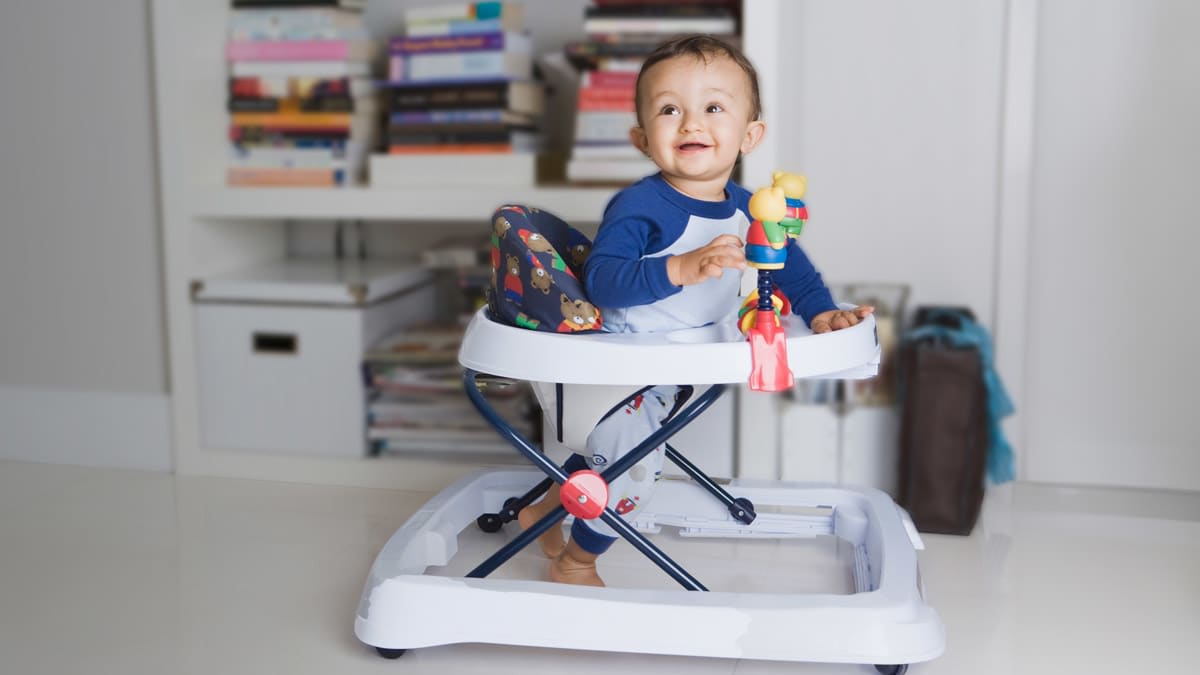Why Baby Walkers Are Unsafe

From 2004 through 2008, the Consumer Product Safety Commission (CPSC) staff estimate there was an average of 3,000 injuries per year related to infant walkers among children under the age of 15 months that were treated in hospital emergency departments. The most common injuries included babies falling out of their walkers or down the stairs, injured heads and faces, contusions and/or abrasions, and injuries to internal organs.
The CPSC also reported eight fatal incidents from 2004 to 2008, one of which appeared to involve a fall from stairs by a child in a walker that didn’t conform to ASTM International standards. According to the AAP, other risks associated with baby walkers include drowning in a bathtub or pool while in a fast-moving walker and being burned or poisoned because reaching high objects is easier in a walker.
In response to the growing number of injuries, the CPSC issued a rule for baby walkers in 2010 that made some ASTM safety standards from 2007 mandatory. Those standards were intended to help prevent stair falls and tip-overs, and to ensure that children were fully supported and their legs couldn’t become trapped. The rules were updated again in 2022 to further address the risk of stair falls.
Applying multiple rounds of increasingly strict standards seems to have worked—but only up to a point. According to the CPSC’s 2024 nursery products report, the National Electronic Injury Surveillance System (NEISS) reported an estimated annual average of 2,467 injuries to children under age 5 in baby walkers, jumpers, or exercisers between 2021 and 2023 that were treated in emergency departments. (This newer data groups baby walkers with stationary jumpers and exercisers.)
According to MRI Simmons, a market research company, 351,000 fewer baby walkers were sold to consumers in 2023 than in 2013. Given this data, the number of injuries is just as significant—and the AAP, as well as advocacy groups like Kids in Danger, say walkers are never safe to use and safety regulations fall short.
James Dodington, MD, a pediatric emergency medicine doctor and an executive committee member of the Council on Injury, Violence and Poison Prevention at the AAP, says he had seen many children injured by walkers, including hand-me-down devices that may have been manufactured before the CPSC’s 2010 rule.
“Maybe we’re not seeing as much of the fall down the stairs, but the risks are numerous and the AAP would point out that they aren’t just about the fall risk, but there’s also other dangers and risks that come from them,” Dodington says. There are high risks of injury to the head and neck in walkers, he says, as well as burns from accessing a hot stove or being rolled inadvertently into a pool or body of water.
“One thing that’s really not well understood, I think by the public in general, is just how fast infants can travel in these walkers—multiple feet per second,” Dodington says.
Even with multiple rounds of increasingly strict standards to make baby walkers safer, they continue to present serious safety concerns. In 2014, about 3,600 BebeLove Baby Walkers were recalled because they could fit through a standard doorway (which violated updated safety standards) and posed entrapment hazards. In 2022, the CPSC recalled about 1,355 Zeno infant walkers because of fall and entrapment hazards. (Zeno is no longer in business.) Recently, in 2024, the agency warned against using Comfi Baby Infant Walkers, which were sold exclusively on Amazon, due to fall and entrapment hazards.
Despite repeated recalls, updated safety standards, and warnings from experts like the AAP, baby walkers continue to be sold all over in the U.S., and their use sends thousands of young children to emergency rooms every year. CR asked the CPSC if it would consider a ban on baby walkers given the many injuries that still occur with them. It responded with the following statement: “Staff constantly review incident data with a view toward ensuring that standards continue to address product hazards. To the extent that staff recommend additional improvements to the mandatory standard, the Commission will consider how best to act on those recommendations.”
Source link






